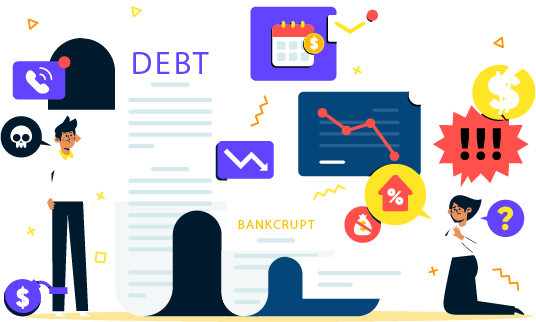Debt Management Plan
A debt management plan (or DMP) is a way to get yourself out of debt and rebuild your credit, all while making monthly payments that fit your budget. They can be extremely beneficial for someone who is in over their head with debt and needs help getting a handle on it.
While participating in a debt management plan, you’ll also learn how to manage your money better so that you can avoid falling into debt again in the future.
Explore a debt management plan

If you’re struggling to manage debt, it may be time to explore a debt management plan (DMP). A DMP is a tool offered by credit counselors to help borrowers pay off their debt within a few years. While a DMP can help reduce what you owe and improve your credit, it may not be for everyone.
Financial strategy to pay off

A debt management plan is a financial strategy to pay off unsecured debt, typically from credit cards, within three to five years. The process is led by a credit counselor. Credit counseling services are often nonprofit organizations. They help consumers better manage their debt at little to no cost, though you may need to pay a startup fee and monthly service fees.
Counselor can negotiate with your creditors

With a DMP, your credit counselor can negotiate with your creditors on your behalf to do things like waive fees, decrease your interest rates or lower your monthly payments. This can make your bills more affordable and help you to pay off debt faster.
DMP can be a helpful tool

While you’re in a DMP, you’ll provide payments to your credit counseling agency, which will then pay your creditors. As you repay your debt, your credit utilization ratio will decrease and you may see your credit score improve. While your DMP won’t be listed on your credit report, the accounts enlisted in the plan may be recorded as being paid through a DMP — though this should be removed once the balances are paid off.
DMP can be a helpful tool

A DMP can be a helpful tool if you’re feeling overwhelmed, but the pros and cons of debt management plans can depend on your financial situation.

Few mostly used methods in DMP for betterment of finances
The debt avalanche method, also known as debt stacking, looks a lot like the debt snowball method — but with one key distinction. Instead of paying off the smallest balance first, you start with the highest interest rate and work your way down.
Make a list of all your credit card debt balances and order them from smallest to largest.
Pay the minimum amount on each debt every month, but make extra payments on your smallest debt.
Once you repay that debt, take the money you’ve freed up and pay off the next smallest debt.
Cycle through steps 2 to 3 until you have paid off all your debt.
As an example, let’s say you have the following debt accounts:
- Account A: 6,000 balance and 21.0% APR
- Account B: $15,000 balance and 16.2% APR
- Account C: $2000 balance and 19.5% APR
If you follow the debt snowball method, you would pay off Account C first, as it has the smallest balance. Once it’s repaid, you’d target Account A and then finally Account B. Conquering smaller balances one at a time gives you motivation to tackle the next. And as you clear your debts, you free up more funds for the next account.
This method is not without its disadvantages, however. You might pay more in interest charges compared to other debt repayment strategies, such as a debt avalanche. That’s because a debt snowball doesn’t take interest rates into account, so you could spend several months paying off a low-cost debt. But if quick wins keep you motivated, then a debt snowball can be an effective strategy.
The debt avalanche method, also known as debt stacking, looks a lot like the debt snowball method — but with one key distinction. Instead of paying off the smallest balance first, you start with the highest interest rate and work your way down.
Here’s what it would look like applied to the example from the previous section:
- Account A: $6,000 balance and 21.0% APR
- Account B: $15,000 balance and 16.2% APR
- Account C: $2000 balance and 19.5% APR
In this situation, you would pay down Account A first, Account C next and Account B last.
The debt avalanche is a great option if you want to spend less on fees and get out of credit card debt quicker. Credit cards with high interest rates can keep you in the red longer as a larger part of your monthly payments go toward paying interest rather than decreasing the principal.
By tackling debts with the highest interest rates first, you’ll get rid of these pesky penalties sooner and free up more funds to pay off the rest of your credit card balances. Just like an avalanche, it takes a lot before you see any changes. But once you reach the tipping point, everything falls into place quicker than you’d expect.
However, because it can take longer to see results compared to a debt snowball, this repayment strategy can be discouraging for some people
Debt snowball method vs. debt avalanche method
Wondering what’s better for you — a debt snowball versus a debt avalanche? Here’s what you need to know if you’re choosing between the two:
The debt snowball method is arguably more popular and involves paying off debts from smallest balance to largest balance without taking APR into consideration. Because you start by paying off debts with the smallest balance, you often knock out entire balances more quickly than you would with the debt avalanche method.
For most people, a debt snowball works best when they have a steady amount of extra cash to pay off debt. That’s because this repayment method assumes that as soon as one debt is paid off, you’ll take the minimum that you would have paid on that debt and apply to the debt with the next smallest balance — in effect “snowballing” the amount you owe.
Many people like the debt snowball method because of the motivation that comes from paying off a debt once and for all — often in as little as a few months. While the debt avalanche method will help you save more money on interest and pay off your overall debt sooner, research has shown people tend to be more successful with the debt snowball method because of the psychological boost that comes from eliminating an entire balance.

Benefits of a Debt Management Plan
- A debt management plan is a system that allows you to pay one monthly payment that covers all of your included debt. Essentially, once your creditors agree to the plan, you make a single payment each month to the facilitator of your debt management plan. It’s not a loan, however, and your monthly payment is divided and dispersed to your creditors every month.
- When you request a debt management plan and your creditors agree to it, they will often lower your interest rate and waive any late fees that you currently have. They will also agree to a set monthly payment that has your account paid in full in no more than five years. For most clients, these benefits lead to massive savings over the course of the repayment plan.
Modinest
Lorem ipsum dolor sit amet, consectetur adipiscing elit, sed do eiusmod tempor incididunt ut labore et dolore magna aliqua.
- Ullamco laboris nisi ut aliquip ex ea commodo consequat.
- Duis aute irure dolor in reprehenderit in voluptate velit.
- Ullamco laboris nisi ut aliquip ex ea commodo consequat. Duis aute irure dolor in reprehenderit in voluptate trideta storacalaperda mastiro dolore eu fugiat nulla pariatur.
Ullamco laboris nisi ut aliquip ex ea commodo consequat. Duis aute irure dolor in reprehenderit in voluptate velit esse cillum dolore eu fugiat nulla pariatur. Excepteur sint occaecat cupidatat non proident, sunt in culpa qui officia deserunt mollit anim id est laborum

Undaesenti
Ullamco laboris nisi ut aliquip ex ea commodo consequat. Duis aute irure dolor in reprehenderit in voluptate velit esse cillum dolore eu fugiat nulla pariatur. Excepteur sint occaecat cupidatat non proident, sunt in culpa qui officia deserunt mollit anim id est laborum
Lorem ipsum dolor sit amet, consectetur adipiscing elit, sed do eiusmod tempor incididunt ut labore et dolore magna aliqua.
- Ullamco laboris nisi ut aliquip ex ea commodo consequat.
- Duis aute irure dolor in reprehenderit in voluptate velit.
- Provident mollitia neque rerum asperiores dolores quos qui a. Ipsum neque dolor voluptate nisi sed.
- Ullamco laboris nisi ut aliquip ex ea commodo consequat. Duis aute irure dolor in reprehenderit in voluptate trideta storacalaperda mastiro dolore eu fugiat nulla pariatur.

Pariatur
Ullamco laboris nisi ut aliquip ex ea commodo consequat. Duis aute irure dolor in reprehenderit in voluptate velit esse cillum dolore eu fugiat nulla pariatur. Excepteur sint occaecat cupidatat non proident, sunt in culpa qui officia deserunt mollit anim id est laborum
- Ullamco laboris nisi ut aliquip ex ea commodo consequat.
- Duis aute irure dolor in reprehenderit in voluptate velit.
- Provident mollitia neque rerum asperiores dolores quos qui a. Ipsum neque dolor voluptate nisi sed.
Lorem ipsum dolor sit amet, consectetur adipiscing elit, sed do eiusmod tempor incididunt ut labore et dolore magna aliqua.

Nostrum
Ullamco laboris nisi ut aliquip ex ea commodo consequat. Duis aute irure dolor in reprehenderit in voluptate velit esse cillum dolore eu fugiat nulla pariatur. Excepteur sint occaecat cupidatat non proident, sunt in culpa qui officia deserunt mollit anim id est laborum
Lorem ipsum dolor sit amet, consectetur adipiscing elit, sed do eiusmod tempor incididunt ut labore et dolore magna aliqua.
- Ullamco laboris nisi ut aliquip ex ea commodo consequat.
- Duis aute irure dolor in reprehenderit in voluptate velit.
- Ullamco laboris nisi ut aliquip ex ea commodo consequat. Duis aute irure dolor in reprehenderit in voluptate trideta storacalaperda mastiro dolore eu fugiat nulla pariatur.

Adipiscing
Ullamco laboris nisi ut aliquip ex ea commodo consequat. Duis aute irure dolor in reprehenderit in voluptate velit esse cillum dolore eu fugiat nulla pariatur. Excepteur sint occaecat cupidatat non proident, sunt in culpa qui officia deserunt mollit anim id est laborum
Lorem ipsum dolor sit amet, consectetur adipiscing elit, sed do eiusmod tempor incididunt ut labore et dolore magna aliqua.
- Ullamco laboris nisi ut aliquip ex ea commodo consequat.
- Duis aute irure dolor in reprehenderit in voluptate velit.
- Ullamco laboris nisi ut aliquip ex ea commodo consequat. Duis aute irure dolor in reprehenderit in voluptate trideta storacalaperda mastiro dolore eu fugiat nulla pariatur.

Reprehit
Ullamco laboris nisi ut aliquip ex ea commodo consequat. Duis aute irure dolor in reprehenderit in voluptate velit esse cillum dolore eu fugiat nulla pariatur. Excepteur sint occaecat cupidatat non proident, sunt in culpa qui officia deserunt mollit anim id est laborum
Lorem ipsum dolor sit amet, consectetur adipiscing elit, sed do eiusmod tempor incididunt ut labore et dolore magna aliqua.
- Ullamco laboris nisi ut aliquip ex ea commodo consequat.
- Duis aute irure dolor in reprehenderit in voluptate velit.
- Ullamco laboris nisi ut aliquip ex ea commodo consequat. Duis aute irure dolor in reprehenderit in voluptate trideta storacalaperda mastiro dolore eu fugiat nulla pariatur.

Our Pricing
Architecto nobis eos vel nam quidem vitae temporibus voluptates qui hic deserunt iusto omnis nam voluptas asperiores sequi tenetur dolores incidunt enim voluptatem magnam cumque fuga.
Free Plan
$0 / month
- Quam adipiscing vitae proin
- Nec feugiat nisl pretium
- Nulla at volutpat diam uteera
- Pharetra massa massa ultricies
- Massa ultricies mi quis hendrerit
Business Plan
$29 / month
- Quam adipiscing vitae proin
- Nec feugiat nisl pretium
- Nulla at volutpat diam uteera
- Pharetra massa massa ultricies
- Massa ultricies mi quis hendrerit
Developer Plan
$49 / month
- Quam adipiscing vitae proin
- Nec feugiat nisl pretium
- Nulla at volutpat diam uteera
- Pharetra massa massa ultricies
- Massa ultricies mi quis hendrerit
Frequently Asked Questions
Lorem ipsum dolor sit amet, consectetur adipiscing elit, sed do eiusmod tempor incididunt ut labore et dolore magna aliqua. Duis aute irure dolor in reprehenderit
Portfolio
Non hic nulla eum consequatur maxime ut vero memo vero totam officiis pariatur eos dolorum sed fug dolorem est possimus esse quae repudiandae. Dolorem id enim officiis sunt deserunt esse soluta consequatur quaerat
Our Team
Architecto nobis eos vel nam quidem vitae temporibus voluptates qui hic deserunt iusto omnis nam voluptas asperiores sequi tenetur dolores incidunt enim voluptatem magnam cumque fuga.

Walter White
Chief Executive Officer
Sarah Jhonson
Product Manager
William Anderson
CTOBlog
Recent posts form our Blog

Eum ad dolor et. Autem aut fugiat debitis voluptatem consequuntur sit
Illum voluptas ab enim placeat. Adipisci enim velit nulla. Vel omnis laudantium. Asperiores eum ipsa est officiis. Modi cupiditate exercitationem qui magni est...
Read More
Et repellendus molestiae qui est sed omnis voluptates magnam
Voluptatem nesciunt omnis libero autem tempora enim ut ipsam id. Odit quia ab eum assumenda. Quisquam omnis aliquid necessitatibus tempora consectetur doloribus...
Read More
Quia assumenda est et veritatis aut quae
Quia nam eaque omnis explicabo similique eum quaerat similique laboriosam. Quis omnis repellat sed quae consectetur magnam veritatis dicta nihil...
Read MoreContact Us
Ea vitae aspernatur deserunt voluptatem impedit deserunt magnam occaecati dssumenda quas ut ad dolores adipisci aliquam.
Get in touch
Et id eius voluptates atque nihil voluptatem enim in tempore minima sit ad mollitia commodi minus.
Location:
A108 Adam Street, New York, NY 535022
Email:
info@example.com
Call:
+1 5589 55488 55


















